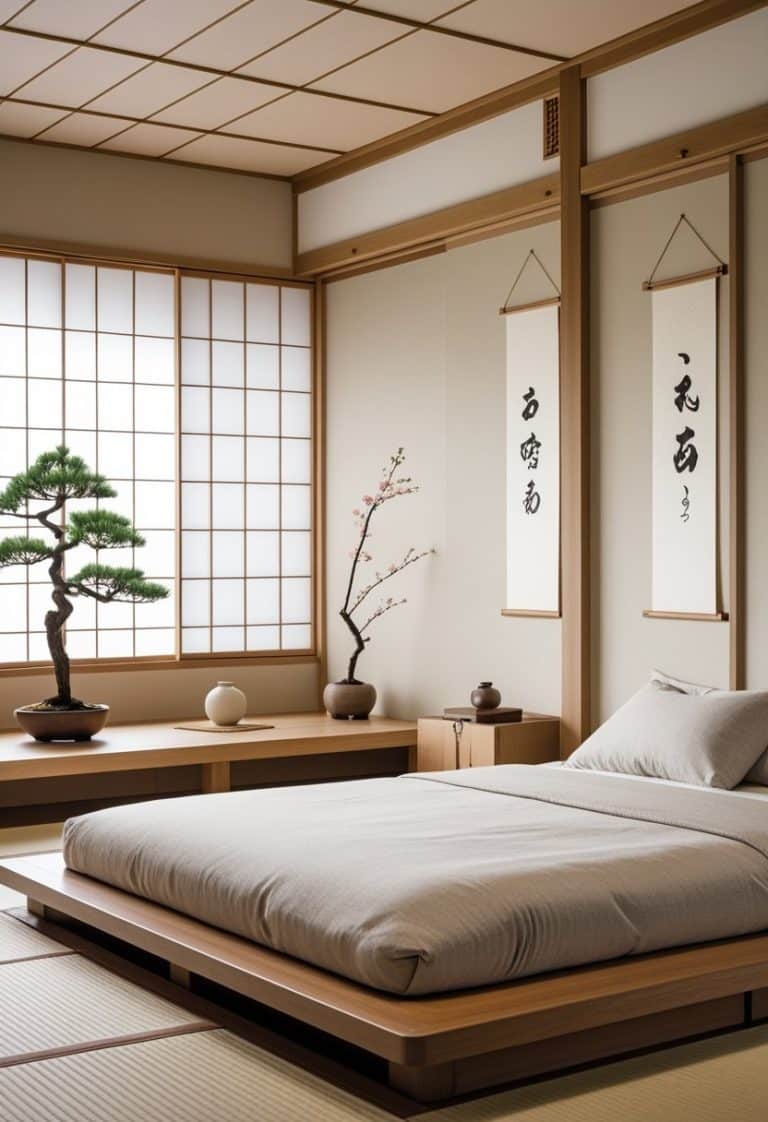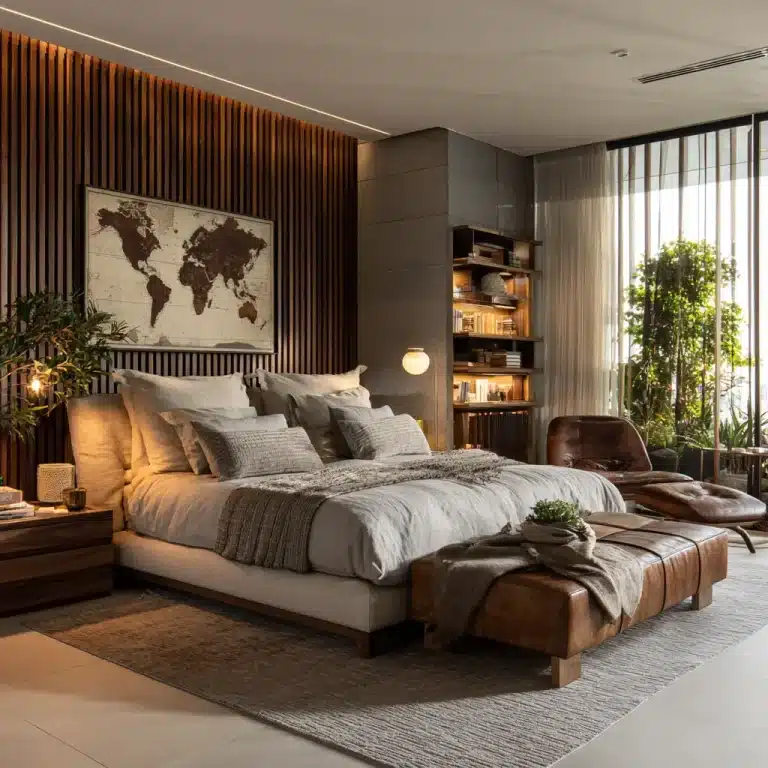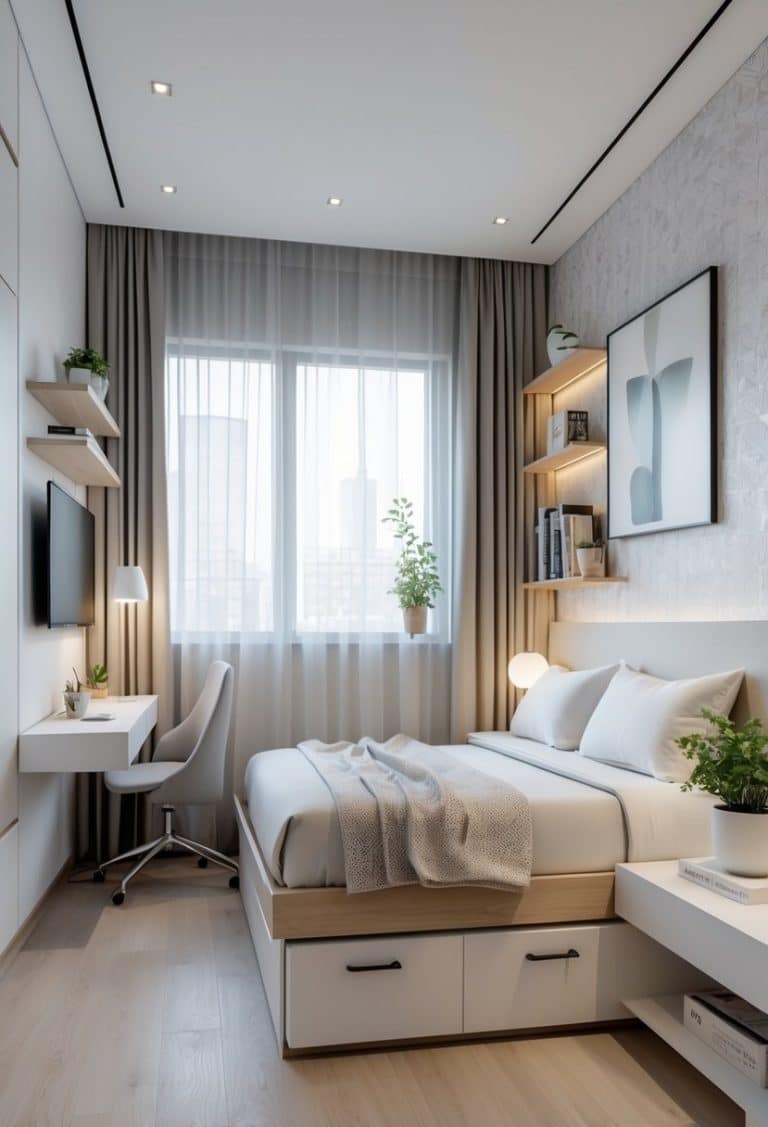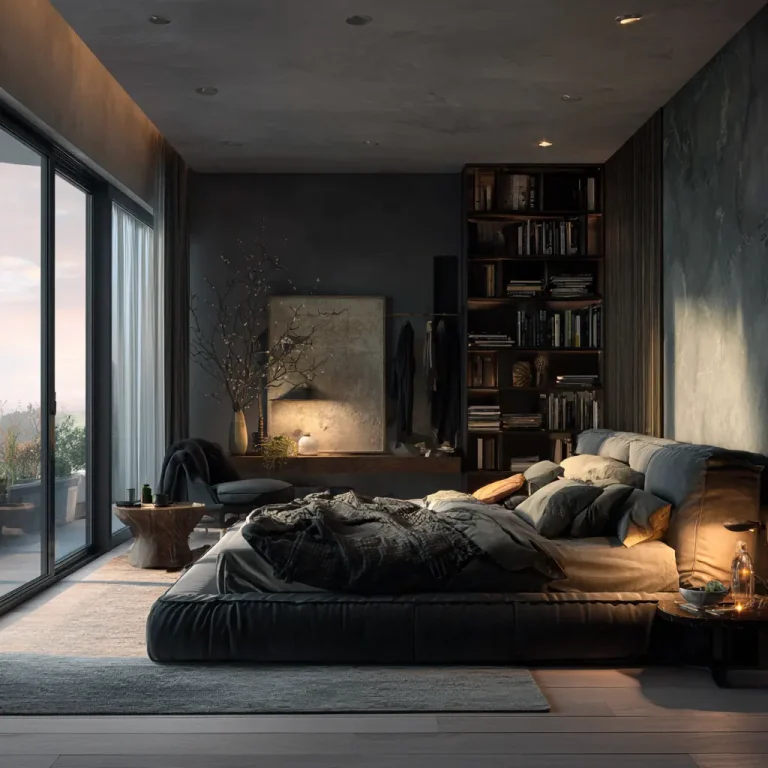Eclectic Bedroom Design With Natural Textures: 22 Inspiring Ideas for a Balanced and Stylish Space

Eclectic bedroom design allows a space to feel both personal and balanced by blending different styles, colors, and textures. Natural materials such as wood, stone, and woven fibers play an important role in grounding the mix, giving the room warmth and character without overwhelming it. The combination of eclectic design and natural textures creates a bedroom that feels unique, inviting, and timeless.

This approach moves beyond a single style and instead layers elements that reflect individuality while still maintaining harmony. By weaving in organic textures, handcrafted details, and thoughtful accents, the space becomes more than just a place to sleep—it becomes a curated environment that feels both comfortable and expressive.
Incorporate rough-hewn wood paneling for rustic warmth

Rough-hewn wood paneling adds texture and depth to an eclectic bedroom. Its natural grain and uneven surface create a grounded backdrop that pairs well with both vintage and modern furniture.
This type of paneling works especially well on a feature wall, drawing attention without overwhelming the space. Lighter finishes can brighten the room, while darker tones add a cozy feel.
When combined with colorful fabrics or patterned decor, the wood’s raw character balances out bold details. The result is a layered look that feels warm, inviting, and connected to nature.
Use woven baskets as stylish storage solutions

Woven baskets offer both function and style in a bedroom. They keep everyday items organized while adding natural texture to the space.
Made from materials like rattan, wicker, or seagrass, they blend well with eclectic interiors. Their neutral tones work with many color schemes.
They can hold blankets, pillows, or magazines near the bed. Smaller baskets fit well on shelves or under nightstands for discreet storage.
Layer natural fiber rugs like jute or sisal

Natural fiber rugs such as jute and sisal bring texture and warmth to a bedroom. Their neutral tones make them easy to pair with patterned or colorful rugs.
Layering a flat sisal rug under a smaller accent rug creates depth without overwhelming the space. This approach also helps anchor furniture and define areas in the room.
Jute rugs add a softer, slightly rustic look compared to sisal. When combined, these natural fibers balance durability with a relaxed, grounded style.
Add linen bedding for breathable texture

Linen bedding adds a natural layer of texture to an eclectic bedroom. Its slightly coarse weave gives the bed a relaxed, lived-in look without appearing messy.
The fabric is breathable, which helps regulate temperature through different seasons. This makes it practical as well as visually appealing.
Linen pairs well with other natural materials like wool or cotton. Layering these fabrics creates depth and keeps the space comfortable without feeling heavy.
Mix stone accents such as pebble trays or lamps

Stone accents add texture and a grounded feel to an eclectic bedroom. Pebble trays can sit on nightstands or dressers, offering a simple way to bring in natural detail.
Stone lamps provide both function and style. Their solid bases contrast well with softer fabrics and wood finishes in the room.
Using small stone elements keeps the design balanced. They add interest without overwhelming other textures like linen, jute, or wood.
Combine vintage and modern furniture pieces

Blending vintage and modern furniture creates balance and interest in an eclectic bedroom. A sleek bed frame can sit comfortably beside an antique nightstand without looking out of place.
They can pair a modern dresser with a vintage chair or mirror to add character. The mix highlights contrast while keeping the room functional.
Using both styles allows flexibility in design. Vintage pieces bring warmth and history, while modern furniture adds clean lines and simplicity. Together, they form a space that feels layered and personal.
Introduce indoor plants for organic vibrancy

Indoor plants add natural texture and color that balance eclectic bedroom styles. They soften strong design choices and bring a sense of freshness to the room.
Placing plants in woven baskets, ceramic pots, or metal planters can highlight different materials and finishes. This variety supports the layered look common in eclectic spaces.
Low-maintenance plants like snake plants or pothos work well for bedrooms. They require little care while still adding greenery and visual interest.
Use macramé wall hangings for tactile interest

Macramé wall hangings add texture that softens flat surfaces and brings depth to a bedroom. Their woven patterns create subtle shadows and visual variety without taking up floor space.
They work well with natural materials like wood, cotton, or jute, which support an eclectic and relaxed style. The handmade quality also introduces a personal element to the room.
Placing macramé above a bed, console, or small nook can highlight areas that might otherwise feel plain. Different sizes and knot styles allow flexibility in how much detail or presence they bring to the space.
Blend colorful patterned throws with neutral bases

Colorful throws add variety and interest when layered over simple bedding. Patterns such as stripes, florals, or geometric prints stand out more against a plain backdrop.
A neutral base, like white, beige, or gray, keeps the space balanced. It prevents the room from feeling too busy while allowing the patterned textiles to remain the focus.
This mix also makes it easy to update the look. Swapping throws or adding new accent colors can refresh the room without changing the main furniture or wall color.
Feature sculptural ceramic vases

Sculptural ceramic vases add texture and shape that fit well in an eclectic bedroom. Their natural finishes and varied forms bring interest without overwhelming the space.
They work both as stand-alone pieces and as vessels for greenery or dried branches. This flexibility makes them easy to place on nightstands, shelves, or dressers.
Handmade or textured designs enhance the layered look of mixed materials. By combining smooth ceramics with wood, fabric, or stone, the room feels more balanced and visually engaging.
Install rattan or wicker light fixtures

Rattan and wicker light fixtures add texture and warmth to a bedroom. Their woven designs create soft patterns of light that make the space feel inviting without overwhelming other elements.
They pair well with both bold colors and neutral tones, making them easy to fit into eclectic styles. The natural materials also balance modern or vibrant pieces with an earthy touch.
These fixtures come in many shapes and sizes, from simple pendants to tiered designs. This variety allows homeowners to choose options that match their room’s scale and layout.
Include reclaimed wood nightstands

Reclaimed wood nightstands add both function and character to an eclectic bedroom. Their natural grain and imperfections create texture that blends well with mixed styles.
They work well beside modern, rustic, or vintage pieces without looking out of place. Each piece often feels unique because of the wood’s varied tones and patterns.
Using reclaimed wood also supports sustainable design. Many homeowners choose these nightstands to reduce waste while adding warmth and depth to their space.
Display handcrafted pottery

Handcrafted pottery adds depth and character to an eclectic bedroom. Each piece brings unique shapes, colors, and textures that complement natural materials like wood and stone.
They can place pottery on shelves, bedside tables, or window ledges to highlight its form. In-wall niches or simple stands also work well to showcase pottery without taking up much space.
Mixing pottery with woven baskets, textiles, or metal accents creates a balanced display. This layering of materials reflects the eclectic style while keeping the room grounded in natural textures.
Use warm earth tones in paint and textiles

Warm earth tones help create a calm and natural base in an eclectic bedroom. Shades like terracotta, beige, clay, and muted greens work well on walls or accent areas. These colors pair easily with wood and other organic textures.
Textiles in earthy hues add softness and depth. Linen bedding, cotton throws, and woven rugs in warm neutrals or muted tones bring balance. Layering these fabrics builds comfort while keeping the palette grounded in nature.
Add leather accents through chairs or cushions

Leather accents can add depth to an eclectic bedroom without overwhelming the space. A small leather chair in the corner or a simple bench at the foot of the bed introduces texture and contrast.
Cushions with leather details work well alongside linen, cotton, or knit fabrics. This mix of materials creates balance while keeping the room comfortable.
Even one or two leather pieces can highlight natural textures like wood, rattan, or woven rugs. The smooth surface of leather complements these organic elements and helps tie the design together.
Incorporate woven seagrass baskets

Woven seagrass baskets add natural texture to an eclectic bedroom. Their neutral tones blend well with different styles, from boho to modern.
They work as storage for blankets, pillows, or small items while keeping the space organized. Their lightweight design makes them easy to move and rearrange.
Different sizes and shapes allow flexibility in styling. Placing them beside the bed, under a bench, or in a corner introduces warmth and visual interest.
Mix matte and glossy natural finishes

They can combine matte and glossy finishes to create balance in an eclectic bedroom. Matte wood or stone surfaces bring a soft, grounded feel.
Glossy finishes on accents like side tables, lamps, or frames add light and contrast. This pairing keeps the room from feeling flat.
Using both finishes highlights natural textures. The shift between smooth shine and muted surfaces creates depth without overwhelming the space.
Use raw cotton or hemp curtains

Raw cotton or hemp curtains add a natural look to an eclectic bedroom. Their simple texture pairs well with wood, stone, and woven accents.
These fabrics are breathable and filter light softly, creating a calm atmosphere. They also work with a wide range of colors and patterns.
Because cotton and hemp are durable, they hold up well over time. This makes them a practical choice for everyday use.
Add a wooden bench at the foot of the bed

A wooden bench at the foot of the bed adds a practical surface and a natural element to the room. Its simple form blends well with eclectic interiors that mix styles and textures.
They can use it for seating, storage, or as a place to set blankets and pillows. The natural grain of the wood introduces warmth and subtle visual interest.
Different finishes, from light oak to dark walnut, allow the bench to match or contrast with other furniture. This flexibility makes it easy to fit into a wide range of bedroom designs.
Layer different natural textures for depth

They can create depth in an eclectic bedroom by combining a mix of natural textures. Wood, stone, linen, and woven fibers each bring a distinct surface that adds interest without overwhelming the space.
Layering smooth fabrics with rougher materials helps balance comfort and character. For example, linen bedding pairs well with a rattan headboard or a rustic wooden nightstand.
Adding small touches like woven baskets, wool throws, or textured rugs creates subtle variation. These layers make the room feel inviting while keeping the design cohesive.
Use stone or clay planters for greenery

Stone and clay planters add natural texture that fits well in an eclectic bedroom. Their earthy surfaces create a grounded look that pairs easily with wood, woven fabrics, or metal accents.
These planters also provide a neutral backdrop for plants, letting greenery stand out without overwhelming the space. Their simple forms balance bold or layered decor.
Clay pots work well for plants that need breathable soil, while stone planters add weight and stability. Both choices bring durability and a timeless feel to the room.
Incorporate vintage rugs with natural dyes

Vintage rugs made with natural dyes add subtle color and texture to an eclectic bedroom. Their muted tones often blend well with wood, stone, and woven accents.
These rugs can help tie together different furniture styles or patterns in the room. They provide a grounded focal point without overwhelming the space.
Natural dye variations also give each piece a unique look. This adds character and depth while keeping the design balanced and inviting.
Key Elements of Eclectic Bedroom Design

An eclectic bedroom blends contrast and variety with intention. It focuses on combining colors, textures, and furniture styles in a way that feels cohesive rather than random. Careful balance keeps the space comfortable while still showing personality.
Balancing Patterns and Colors
Patterns and colors play a central role in an eclectic bedroom. Instead of matching everything, the goal is to layer different elements in a way that feels unified. A simple way to achieve this is by choosing a consistent color palette and letting patterns vary within it.
For example, a room might use earth tones as the base, then add stripes, florals, and geometric prints without clashing. Keeping one or two dominant colors helps tie everything together.
Textures also matter. Mixing smooth fabrics like cotton with rougher materials such as linen or woven rattan creates depth. This allows bold colors or patterns to stand out without overwhelming the eye.
A helpful method is to follow the 60-30-10 rule:
- 60% main color (walls, large furniture)
- 30% secondary color (bedding, rugs)
- 10% accent color (pillows, artwork)
This structure provides freedom to experiment while preventing visual chaos.
Mixing Furniture Styles
Furniture in an eclectic bedroom often comes from different design eras. A mid-century modern nightstand can sit next to a rustic wooden bed, and the contrast feels intentional when other elements connect them.
The key is to repeat certain details. A shared wood tone, similar metal finish, or matching fabric can link otherwise different pieces. This repetition creates a sense of order while keeping variety.
Scale is also important. Large, heavy furniture can dominate a small room if not balanced with lighter, open pieces. Pairing a solid wood dresser with a slim metal chair keeps the space from feeling crowded.
Layering old and new pieces adds character. Antique finds bring warmth, while modern items keep the room fresh. The mix works best when arranged with clear spacing, so each piece has room to stand out without competing.
Incorporating Natural Textures

Natural textures bring warmth, depth, and balance to an eclectic bedroom. They add tactile variety, soften bold design choices, and create a more grounded atmosphere that feels both inviting and timeless.
Layering Organic Materials
Layering different natural materials helps a bedroom feel rich and visually interesting. Wood, stone, and woven fibers each add unique qualities that work well together. For example, a reclaimed wood headboard can pair with a jute rug and linen bedding without clashing.
Using a mix of finishes prevents the space from feeling flat. Smooth polished wood contrasts nicely with rough stone or woven baskets. This balance of textures makes the room feel complete rather than overly uniform.
A useful approach is to combine three or more textures in one space:
- Wood: furniture, wall accents, or flooring
- Textiles: cotton, linen, wool, or velvet throws
- Natural fibers: rattan chairs, wicker baskets, or seagrass mats
These layers should be placed where they can be touched and seen often, such as bedding, rugs, and seating. This makes the room feel more comfortable and personal while still maintaining a cohesive look.
Integrating Plants and Greenery
Plants add both texture and life to an eclectic bedroom. Their leaves introduce natural patterns, while pots and planters bring in extra materials like clay, terracotta, or woven fiber. Together, these elements connect the room to nature in a simple but effective way.
Different plant types offer different visual effects. Large leafy plants like monstera or fiddle-leaf fig create bold focal points. Smaller plants such as succulents or ferns work well on shelves, side tables, or windowsills.
Placement matters as much as plant type. Grouping several plants in varying heights creates depth, while a single tall plant in the corner can balance the layout. Choosing low-maintenance species helps keep the space looking fresh without constant upkeep.
By mixing greenery with wood, stone, and fabric, the room gains both softness and structure. This combination makes the space feel balanced and more connected to the natural world.






